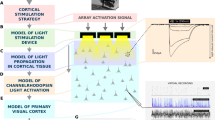Abstract
Recent advances in arrays of microelectrodes open the door to both better understanding of the way the brain works and to the restoration of damaged perceptive and motor functions. In the case of sensorial inputs, direct multi-channel interfacing with the brain for neuro-stimulation requires a computational layer capable of handling the translation from external stimuli into appropriate trains of spikes. The work here presented aims to provide automated and reconfigurable transformation of visual inputs into addresses of microelectrodes in a cortical implant for the blind. The development of neuroprostheses such as this one will contribute to reveal the neural language of the brain for the representation of perceptions, and offers a hope to persons with deep visual impairments. Our system serves as a highly flexible test-bench for almost any kind of retina model, and allows the validation of these models against multi-electrode recordings from experiments with biological retinas. The current version is a PC-based platform, and a compact stand-alone device is under development for the autonomy and portability required in chronic implants. This tool is useful for psychologists, neurophysiologists, and neural engineers as it offers a way to deal with the complexity of multi-channel electrical interfaces for the brain.
Preview
Unable to display preview. Download preview PDF.
Similar content being viewed by others
References
Hubel, D.: Eye, Brain, and Vision, Scientific American Library (1988)
Victor, J.: Temporal aspects of neural coding in the retina and lateral geniculate. Network 10(4), R1–66 (1999); Review. PMID: 10695759.
Maynard, E.M., Nordhausen, C.T., Norman, R.A.: The Utah intracortical electrode array: a recording structure for potential brain-computer interfaces. Electroenceph. Clin. Neurophysiol. 102, 228–239 (1997)
Microelectrodes from Thomas Recording, http://www.thomasrecording.com
Ghovanloo, M., Najafi, K.: A modular 32-site wireless neural stimulating microsystem. IEEE International Solid-State Circuits Conference, Digest of Technical Papers, 226–227 (Febrauary 2004)
Bjarkam, C.R., Sørensen, J.C., Sunde, N.Å., Geneser, F.A., Østergaard, K.: New strategies for the treatment of Parkinson’s disease hold considerable promise for the future management of neurodegenerative disorders. Biogerontology 2, 193–207 (2001)
EC Project SUAW: Stand Up And Walk, http://www.suaw.com
Carmena, J.M., Lebedev, M.A., Crist, R.E., O’Doherty, J.E., Santucci, D.M., Dimitrov, D.F., Patil, P.G., Henriquez, C.S., Nicolelis, M.A.L.: Learning to control a Brain-Machine Interface for Reaching and Grasping by Primates. PLoS Biology 1(2) (October 2003)
The Cyberhand Project, http://www.cyberhand.org
Shepherd, R.K.: Central Auditory Prostheses. In: Horch, K.W., Dhillon, G.S. (eds.) Neuroprosthetics: Theory and Applications. Kluwer Scientific Publishers, Dordrecht (2003) ISBN 981-238-022-1
Sousa, L., Tomás, P., Pelayo, F., Martínez, A., Morillas, C.A., Romero, S.: Bioinspired Stimulus Encoder for Cortical Visual Neuroprostheses. In: Lysaght, P., Rosenstiel, W. (eds.) Ch. 22, New Algorithms, Architectures, and Applications for Reconfigurable Computing. Springer, Heidelberg (2004), ISBN: 1-4020-3127-0
Bongard, M., Ferrandez, J.M., Bolea, J.A., Ammermüller, J., Fernandez, E.: Extracting common features from the responses of different ganglion cell populations. Ophthal Res. 34/S1: 363
Pelayo, F.J., Romero, S., Morillas, C., Martínez, A., Ros, E., Fernández, E.: Translating Image Sequences into Spike Patterns for Cortical Neuro-Stimulation. Neurocomputing 58–60 (June 2004); special issue on Computational Neuroscience: Trends in Research, 885–892(2004) ISSN: 0925-2312
The Mathworks – Matlab and Simulink for technical computing, http://www.mathworks.com
Faugeras, O.: Three-Dimensional Computer Vision. MIT Press, Cambridge (1993)
BIONIC Technologies LLC (now Ciberkinetics Inc.), http://www.cyberkineticsinc.com
Author information
Authors and Affiliations
Editor information
Editors and Affiliations
Rights and permissions
Copyright information
© 2005 Springer-Verlag Berlin Heidelberg
About this paper
Cite this paper
Morillas, C.A., Romero, S.F., Martinez, A., Pelayo, F.J., Fernández, E. (2005). A Computational Tool to Test Neuromorphic Encoding Schemes for Visual Neuroprostheses. In: Cabestany, J., Prieto, A., Sandoval, F. (eds) Computational Intelligence and Bioinspired Systems. IWANN 2005. Lecture Notes in Computer Science, vol 3512. Springer, Berlin, Heidelberg. https://doi.org/10.1007/11494669_63
Download citation
DOI: https://doi.org/10.1007/11494669_63
Publisher Name: Springer, Berlin, Heidelberg
Print ISBN: 978-3-540-26208-4
Online ISBN: 978-3-540-32106-4
eBook Packages: Computer ScienceComputer Science (R0)




